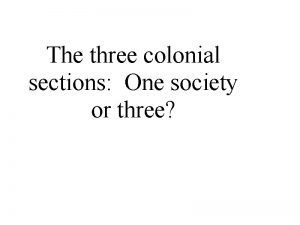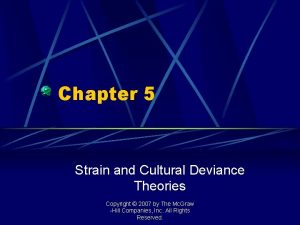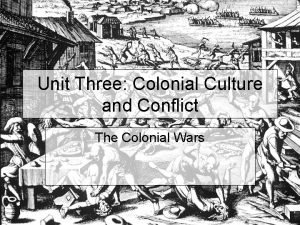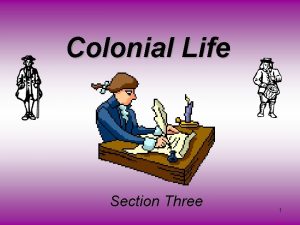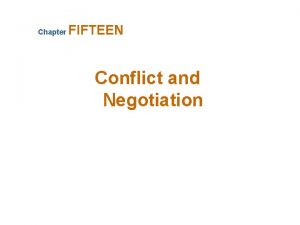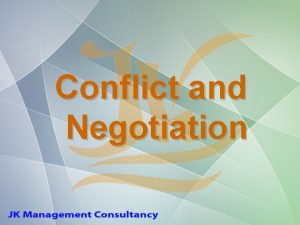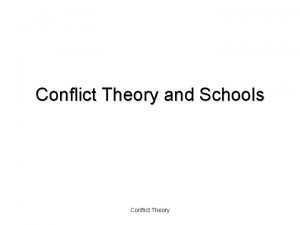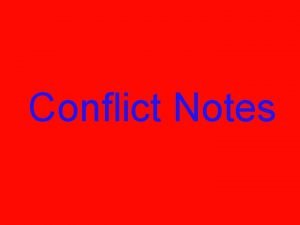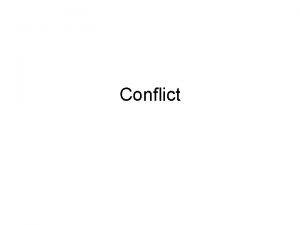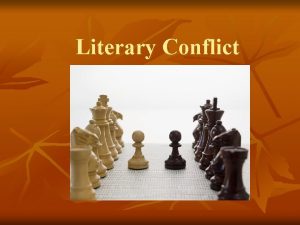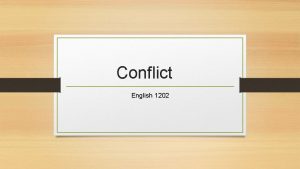Unit Three Colonial Culture and Conflict The Intercontinental






















- Slides: 22

Unit Three: Colonial Culture and Conflict The Intercontinental Wars

The Intercontinental Wars • During the Colonial period while the British settlers were trying to settle and adapt to their new environment, they not only had to fight the Natives but also French and Spanish armies. • From 1689 to 1763 the Colonials were part of a series of Intercontinental Wars collectively known as the French and Indian Wars. • The Wars were fought primarily between the French and British over the dominance (complete control) of North America.

The Intercontinental Wars • The Intercontinental Wars were: – 1. ) King William’s War or War of the Grand Alliance (1689 -1697) – 2. ) Queen Anne’s War or War of the Spanish Succession (1702 -1713) – 3. ) King George's War or War of the Austrian Succession/ War of Jenkins's Ear (1744 -1748) – 4. ) French and Indian War or Seven Year’s War (1754 -1763) • Each conflict was known by two names, one was its name in the colonies and the other was its name in Europe.

King William’s War • King William’s War started in Europe after James II was deposed during the Glorious Revolution (first “peaceful” transfer of power in history) when Parliament (British legislature) replaced him with William of Orange and his wife Mary. • James II was aided by the French leader Louis IVX who was attacked by a Grand Alliance of European countries. • The fighting spread to the Americas with the colonies of New France and the Dominion of New England going to war.

King William’s War • Most of the fighting during King William’s War and the other Intercontinental Wars were fought between the French and British Indian Allies. • The Governor of New France Frontenac used the Algonquians to attack the Iroquois and their allies the British. • In 1690 the French and Algonquians were going to attack Fort Orange, but instead attacked the village of Schenectady at midnight killing most of the people in an event known as the Schenectady Massacre.

King William’s War • The English Colonists then launched an attack on Port Royal taking it, but failed to take the capital of Quebec in the Battle of Quebec; this caused the Colonists to have to fight a defensive war. • In 1692 the French with the Abenaki killed most of the villagers in the town of York (in Maine) known as the Candlemas Massacre. • The Treaty of Ryswick (1697) ended the war and returned everything to status quo antebellum (way before the war).


Queen Anne’s War • Queen Anne’s War started in Europe in 1701 over the fear of the French and Spanish combining their nations into one through marriage. • In 1702 the fighting spread to America with the Colonials fighting a two front war with New France and Spanish Florida. • The Spanish first led a naval bombardment of Charlestown, in return the Carolinians besieged St. Augustine (Siege of St. Augustine) and burned it to the ground with only the fort surviving. • The Carolinians with the aid of the Creek and Chickasaw fought the Choctaw, Seminoles, and killed most the Appalachia in 1704 at the Massacre of the Appalachia.

Queen Anne’s War • In New England Leneuf de Beaubassin led a group of Canadians and Indians on raids through most of the territory. • In response Massachusetts governor Joseph Dudley organized an expedition led by Joseph March to take Port Royal but failed. • Another raid led by Francis Nicholson captured Port Royal which setup an attack on Quebec.

Queen Anne’s War • The Colonials, British regulars, and Iroquois attacked Quebec but failed to take the capital city. • The British and French called an armistice (cease fire) and in 1713 signed the Treaty of Utrecht ending the war with the British receiving Acadia renamed Nova Scotia (New Scotland) and Hudson Bay.

King George’s War • King George’s War started in Europe over the succession of Maria Theresa to the throne of the Holy Roman Emperor, the power struggle engulfed all of Europe. • Conflicts in America began when a Spanish commander boarded an English vessel in the Caribbean cutting off the British Capitan’s ear, Robert Jenkins, to be taken to Parliament as a sign of aggression and a warning to stay out of the Caribbean. • Upon receiving Jenkins and his ear Parliament and George II opened war with Spain.

King George’s War • Most of the war was fought in naval battles in the Caribbean and Indian/colonial confrontations in the settlements of Georgia. • The French quickly joined the war and began Indian attacks, which was answered by the Siege of Louisburg where the French lost control of the fort and control of the St. Lawrence River way. • The French with Indians raided the towns of Albany and Schenectady. • The War ended with the signing of the Treaty of Aix-la-Chapelle, with things going back to status quo antebellum.

French and Indian War • The last of the Intercontinental Wars was the French and Indian War which was the only one to start in the colonies and spread to Europe. • After King George’s War the land of the Ohio Country was left in question with both the French and English claiming it. • The French General Joseph de Montcalm was sent into the Ohio country to build a string of defensive forts along the Ohio River Valley.

French and Indian War • At the same time the French were building forts, the British Ohio Company was selling land grants to colonials to settle the area and for fur trading. • The area was ran by the Virginia Colony led by Governor Robert Dinwiddie. • Dinwiddie wanted to make an agreement with the French, so he sent a young British officer and surveyor, George Washington, to meet with the French, but was turned away.

French and Indian War • Dinwiddie then sent Washington to take a small fort in Western Pennsylvania called Fort Duquesne, which led to the Battle of Jumonville Glen were Washington’s men massacred the French. • Washington then built a small protective fort called Fort Necessity to protect his men from a French counterattack, but due to poor strategy Washington’s men were slaughtered. • The British decided that an army led by Major General Edward Braddock needed to be sent to the colonies to kick the French out of the Ohio Country.

Fort Necessity

French and Indian War • In 1754 delegates from seven colonies meet in Albany, New York to discuss better relations with Indians and how to deal with the French called the Albany Conference. • The delegates agreed on Benjamin Franklin’s Albany Plan of Union to create a unified colonial league of friendship government with a colonial legislative body and a representative to the British Parliament. • The plan was outright rejected by all the colonies.

French and Indian War • The British Campaign of 1755 was an aggressive plan where William Johnson was to take Fort St. Frederic (failed), William Shirley was to take Fort Nigeria (failed), and Edward Braddock was to take Fort Duquesne (failed). • At the Battle of Fort Duquesne Edward Braddock, George Washington (as a scout), and Braddock’s army were ambushed and the lead British commander Braddock was killed.

French and Indian War • The French because of their early victories built a new fort called Fort Ticonderoga even closer to British settlements. • To fund further assaults William Pitt, British Secretary of State, raised taxes in England the colonies angering both sides of the Atlantic Ocean. • The French had a string of victories culminating with the Massacre of Fort William Henry which turned the tide of the war.

French and Indian War • In 1758 the British started another aggressive but this time successful conquest: – Jeffery Amherst took Fort Louisburg, Ticonderoga, and St. Frederic. – James Wolfe was sent to take a string of forts that culminated with the Battle of the Plains of Abraham where Wolfe and Montcalm died. – This led to the fall of Quebec and the people fleeing Montreal. (both major cities gone the French had to admit defeat).


French and Indian War • The Treaty of Paris 1763 ended the French and Indian War giving the British Canada, all lands East of the Mississippi River, and Florida. • This effetely gave the British complete dominance over North America. • The French and Indian War though showed some colonial resentment of British control, led to conflict between British regulars (red coats or lobster backs) and Colonial militias, and the beginning of a desire for separation and the creation of a new nation due to increased British control and taxation.
 The three colonial sections-one society or three
The three colonial sections-one society or three Intercontinental taba
Intercontinental taba Vayudoot logistics
Vayudoot logistics External conflict and internal conflict examples
External conflict and internal conflict examples What is conflict and conflict resolution?
What is conflict and conflict resolution? External conflict
External conflict Forms of pop culture
Forms of pop culture Continuous culture and batch culture
Continuous culture and batch culture Difference between american culture and indian culture
Difference between american culture and indian culture Stab culture and stroke culture
Stab culture and stroke culture Folk culture and popular culture venn diagram
Folk culture and popular culture venn diagram How does popular culture diffuse
How does popular culture diffuse Anaerobic medium
Anaerobic medium Folk culture and popular culture venn diagram
Folk culture and popular culture venn diagram Stroke culture method
Stroke culture method Carpet culture microbiology
Carpet culture microbiology Surface culture deep culture and esol
Surface culture deep culture and esol Informal norm
Informal norm Cultural deviance theory sociology
Cultural deviance theory sociology Culture conflict theory
Culture conflict theory Individual culture traits combine to form culture patterns.
Individual culture traits combine to form culture patterns. Batch culture vs continuous culture
Batch culture vs continuous culture Individualistic culture definition
Individualistic culture definition
